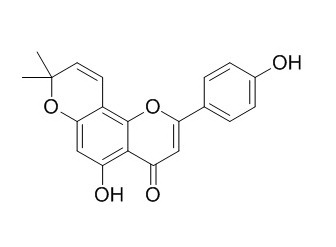Atalantoflavone
Atalantoflavone shows urease inhibitory potential. It displays weak cytotoxic activity against the human Caucasian prostate adenocarcinoma cell line PC-3.
Inquire / Order:
manager@chemfaces.com
Technical Inquiries:
service@chemfaces.com
Tel:
+86-27-84237783
Fax:
+86-27-84254680
Address:
1 Building, No. 83, CheCheng Rd., Wuhan Economic and Technological Development Zone, Wuhan, Hubei 430056, PRC
Providing storage is as stated on the product vial and the vial is kept tightly sealed, the product can be stored for up to
24 months(2-8C).
Wherever possible, you should prepare and use solutions on the same day. However, if you need to make up stock solutions in advance, we recommend that you store the solution as aliquots in tightly sealed vials at -20C. Generally, these will be useable for up to two weeks. Before use, and prior to opening the vial we recommend that you allow your product to equilibrate to room temperature for at least 1 hour.
Need more advice on solubility, usage and handling? Please email to: service@chemfaces.com
The packaging of the product may have turned upside down during transportation, resulting in the natural compounds adhering to the neck or cap of the vial. take the vial out of its packaging and gently shake to let the compounds fall to the bottom of the vial. for liquid products, centrifuge at 200-500 RPM to gather the liquid at the bottom of the vial. try to avoid loss or contamination during handling.
Foods.2020, 9(10):1348.
Biochem Biophys Res Commun.2020, 530(1):4-9.
Front Chem.2022, 10:1048467.
Horticulturae2024, 10(4), 382.
J Pharmaceut Biomed2020, 182:113110
Biomedicine & Pharmacotherapy2022, 153:113404.
Separations2023, 10(4), 231.
Acta horticulturae2017, 1158:257-268
OENO One2023, 57:3.
J Food Sci.2022, 87(11):4905-4916.
Related and Featured Products
Bmc Complementary & Alternative Medicine, 2015 , 15 (1) :1-7.
Antibacterial activities of the methanol extracts and compounds from Erythrina sigmoidea against Gram-negative multi-drug resistant phenotypes.[Pubmed:
26715029]
METHODS AND RESULTS:
In the present study, the methanol extracts from the leaves, as well as compounds namely sigmoidin I (1), Atalantoflavone (2), bidwillon A (3), neocyclomorusin (4), 6α-hydroxyphaseollidin (5) and neobavaisoflavone (6) (from the bark extract) were tested for their activities against a panel of Gram-negative bacteria including multi-drug resistant (MDR) phenotypes. Methods Broth microdilution method was used to determine the minimum inhibitory concentrations (MICs) and the minimum bactericidal concentrations (MBCs) of the extracts as well as compounds 1–6. Results The MIC results indicated that the crude extracts from the leaves and bark of this plant were able to inhibit the growth of 96.3 % of the 27 tested bacteria.
CONCLUSIONS:
Compounds 2–6 displayed selective activities, their inhibitory effects being obtained on 8.3 %, 41.7 %, 58.3 %, 58.3 % and 66.7 % of tested bacteria respectively for 2, 3, 5, 6 and 4. The lowest MIC value of 8 μg/mL was obtained with 6 against Escherichia coli ATCC8739, Enterobacter cloacae ECCI69, Klebsiella pneumoniae KP55, Providencia stuartii NAE16 and Pseudomonas aeruginosa PA01.
Zeitschrift Für Naturforschung B, 2015 , 70 (1) :71-75.
A prenylated acridone alkaloid and ferulate xanthone from barks of Citrus medica (Rutaceae)[Reference:
WebLink]
METHODS AND RESULTS:
A new prenylated acridone alkaloid, medicacridone (1), and a new ferulate xanthone, medicaxanthone (5), together with 11 known compounds were isolated from the methanol extract of the bark of the Cameroonian medicinal plant Citrus medica. The structures of all compounds were determined by comprehensive analyses of their 1D and 2D NMR, mass spectral (EI and ESI) data, chemical reactions, and comparison with previously known analogues.
CONCLUSIONS:
The agar diffusion test delivered low to missing antimicrobial activities, corresponding with MICs > 1 mg mL–1, while compounds 1–6 and Atalantoflavone (9) displayed weak cytotoxic activity against the human Caucasian prostate adenocarcinoma cell line PC-3, with IC50 values ranging from 60.5 to 80.0 μm versus doxorubicine with IC50=0.9 μm.
J Enzyme Inhib Med Chem. 2013 Dec;28(6):1156-61.
Urease inhibitory isoflavonoids from different parts of Calopogonium mucunoides (Fabaceae).[Pubmed:
23057815]
METHODS AND RESULTS:
The dichloromethane-methanol (1:1) soluble part of Calopogonium mucunoides (Fabaceae) resulted in the isolation of 10 isoflavones (4'-O-methylalpinumisoflavone, 4'-O-methylderrone, alpinumisoflavone, daidzeine, Calopogonium isoflavone A, Atalantoflavone, 2',4',5',7-tetramethoxyisoflavone, 7-O-methylcuneantin, cabreuvin and 7-O-methylpseudobaptigenin) and a rotenoid (6a,12a-dehydroxydegueline). Among these, daidzeine, 7-O-methylcuneantin, Atalantoflavone and 6a, 12a-dehydroxydegueline have been isolated for the first time from C. mucunoides while remaining are already reported from this source. Structures of all the isolated constituents were elucidated with the aid of NMR spectroscopic and mass spectrometric techniques.
CONCLUSIONS:
Among all the isolated constituents, nine were evaluated for their urease inhibitory potential. However, six were found potent. These include 4'-O-methylderrone, daidzeine, Atalantoflavone, 2',4',5',7-tetramethoxyisoflavone, 7-O-methylcuneantin and 6a, 12a-dehydroxydegueline.
Isocarlinoside
Catalog No: CFN95092
CAS No: 83151-90-0
Price: $318/5mg
Caraganaphenol A
Catalog No: CFN95093
CAS No: 174916-31-5
Price: $333/5mg
1,3,6-Trihydroxy-2-methylanthraquinone 3-O-(6'-O-acetyl)-alpha-L-rhamnosyl-(1->2)-Beta-D-glucoside
Catalog No: CFN95095
CAS No: 87686-87-1
Price: $218/10mg
Leachianol F
Catalog No: CFN95147
CAS No: 164123-50-6
Price: $318/5mg
Momordicine II
Catalog No: CFN95167
CAS No: 91590-75-9
Price: $318/10mg
[(1(10)E,2R,4R)]-2-Methoxy-8,12-epoxygemacra-1(10),7,11-trien-6-one
Catalog No: CFN95198
CAS No: 75412-95-2
Price: $318/10mg
3',4',5',5,7-Pentamethoxyflavanone
Catalog No: CFN95414
CAS No: 479672-30-5
Price: $218/20mg
Senkyunolide N
Catalog No: CFN95449
CAS No: 140694-58-2
Price: $318/10mg
3beta-(alpha-L-Arabinopyranosyloxy)urs-12,18-dien-28-oic acid beta-D-glucopyranosyl ester
Catalog No: CFN95459
CAS No: 435269-07-1
Price: $318/20mg
Peltatoside 7-O-beta-glucopyranoside
Catalog No: CFN95565
CAS No: 813466-12-5
Price: $318/20mg



